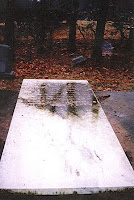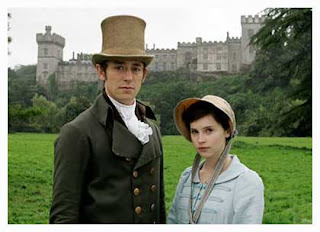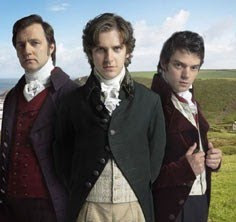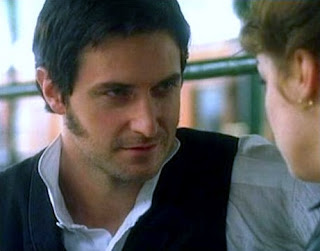Happy Tuesday, everyone! Hope you’re all ready for Thanksgiving (I’m going shopping for the ingredients for a chocolate-cherry cake later! Wish me luck, I haven’t tried this one before). I’ve been unpacking from my trip last week (the book signing was a big success!), and diving into a new book. I love them at this point, when they’re all shiny and new and the characters haven’t started acting all stubborn yet.
 I also have a holiday contest! Visit my Laurel McKee website before December 16 and enter for a chance to win an ARC of Countess of Scandal (out in February 2010!!)
I also have a holiday contest! Visit my Laurel McKee website before December 16 and enter for a chance to win an ARC of Countess of Scandal (out in February 2010!!)
Speaking of stubborn characters, I found out today is the birthday of one of my favorite childhood authors, Frances Hodgson Burnett! I first encountered her work when I found a battered old copy of The Secret Garden at my grandmother’s house, and I love, love, loved that book. I wanted to go live at a crumbling, dark old manor house on the moors and work in the garden. I even loved cranky little Mary, who, unlike those horrible Elsie Dinsmore stories my grandmother tried to push on me, got to be unhappy and contrary (until nature saved her!). I also loved A Little Princess, with solemn, smart Sara and the gorgeous descriptions of her luscious wardrobe (until she was banished to the garret!). These stories created a world I adored and wanted to learn more about. I guess they were my first intro to the British historical.
 Frances Hodgson was born in Manchester on November 24, 1849. When she was 4, her father died, leaving her mother with 5 children to raise on her own. Her mother tried to carry on with the family business, running a wholesale company that supplied art materials to manufacturers, but the company soon failed. Through these trials, little Frances was growing up precocious and observant. She wrote her first poem at age 7. In 1864, her family moved to Knoxville, Tennessee to join her mother’s brother, but their finances did not improve.
Frances Hodgson was born in Manchester on November 24, 1849. When she was 4, her father died, leaving her mother with 5 children to raise on her own. Her mother tried to carry on with the family business, running a wholesale company that supplied art materials to manufacturers, but the company soon failed. Through these trials, little Frances was growing up precocious and observant. She wrote her first poem at age 7. In 1864, her family moved to Knoxville, Tennessee to join her mother’s brother, but their finances did not improve.
Following the death of her mother in 1867, 18-year-old Frances was left responsible for her 2 younger siblings, and she turned to writing to support them all. Her first story was published in Godey’s Lady’s Book (Hearts and Diamonds), and she was soon printed regularly in that magazine along with Scribner’s, Peterson’s Ladies’ Magazine, and Harper’s Bazaar. She became known for her ability to combine details of real, working-class life with romantic plots and sensibilities. She usually earned $10 apiece for these tales.
 In 1873 she married Dr. Swan Burnett, a man she had known since she was 15, and had her first child, Lionel, the following year. Her second son, Vivian, was born soon after on an extended trip to Paris. Her first book, That Lass o’Lowrie’s, about a pit girl working in a coal mine, was published in 1877 to great praise. On their return to the US that year the family settled in Washington DC where she began moving in literary circles and entertained lavishly. She was also prolific–she wrote in quick succession Haworth’s (1879), Louisiana (1880), A Fair Barbarian (1881), and Through One Administration (1883), as well as a play Esmeralda (1881). But she often struggled with illness and depression despite her success.
In 1873 she married Dr. Swan Burnett, a man she had known since she was 15, and had her first child, Lionel, the following year. Her second son, Vivian, was born soon after on an extended trip to Paris. Her first book, That Lass o’Lowrie’s, about a pit girl working in a coal mine, was published in 1877 to great praise. On their return to the US that year the family settled in Washington DC where she began moving in literary circles and entertained lavishly. She was also prolific–she wrote in quick succession Haworth’s (1879), Louisiana (1880), A Fair Barbarian (1881), and Through One Administration (1883), as well as a play Esmeralda (1881). But she often struggled with illness and depression despite her success.
In 1885 she published her “breakout book,” Little Lord Fauntleroy, said to be inspired by her son Vivian. This book earned her more than $100,000, with a hugely popular theatrical adaptation following. Velvet suits became worldwide craze, much to the lasting horror of little boys everywhere.
 In 1887 she traveled to Europe with her sons, visiting London for the Queen’s Golden Jubilee and then on to France and Italy. A Little Princess (originally published under the title Sara Crewe) was published at this time. But in 1890 her eldest son died, and she was consumed with grief. She became interested in spiritualism and Theosophy (she wrote about these beliefs in The White People). Her marriage ended in divorce in 1898 and she married her business manager, but this second marriage also ended in divorce less than 2 years later. Her best-known work, The Secret Garden was published in 1911, after she had been living at Great Maytham Hall in England for many years and actually found a hidden garden there.
In 1887 she traveled to Europe with her sons, visiting London for the Queen’s Golden Jubilee and then on to France and Italy. A Little Princess (originally published under the title Sara Crewe) was published at this time. But in 1890 her eldest son died, and she was consumed with grief. She became interested in spiritualism and Theosophy (she wrote about these beliefs in The White People). Her marriage ended in divorce in 1898 and she married her business manager, but this second marriage also ended in divorce less than 2 years later. Her best-known work, The Secret Garden was published in 1911, after she had been living at Great Maytham Hall in England for many years and actually found a hidden garden there.
She lived practically as a hermit, hounded by the gossip press, for the last 17 years of her life in Plandome, New York, and is buried next to her son Vivian in Roslyn Cemetery there.
 Aside from the novels themselves, I have an excellent biography of Burnett, Frances Hodgson Burnett: Beyond the Secret Garden by Angelica Shirley Carpenter and Jean Shirley. And just as an example of the fashion porn in A Little Princess: Her dresses were silk and velvet and India cashmere, her hats and bonnets were covered with bows and plumes, her small undergarments were adorned with real lace, and she returned in the cab to Miss Minchin’s with a doll almost as large as herself, dressed quite as grandly as herself, too.
Aside from the novels themselves, I have an excellent biography of Burnett, Frances Hodgson Burnett: Beyond the Secret Garden by Angelica Shirley Carpenter and Jean Shirley. And just as an example of the fashion porn in A Little Princess: Her dresses were silk and velvet and India cashmere, her hats and bonnets were covered with bows and plumes, her small undergarments were adorned with real lace, and she returned in the cab to Miss Minchin’s with a doll almost as large as herself, dressed quite as grandly as herself, too.
Did you love these books when you were a kid, too? What were some of your childhood favorites? And what are you cooking for the holiday???















